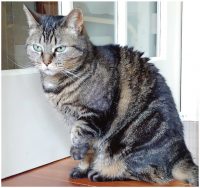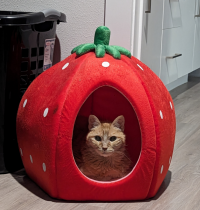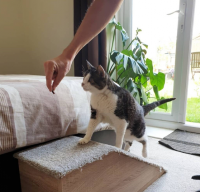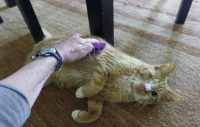Making your home a haven of comfort and accessibility is crucial when caring for a cat who is getting older, or experiencing pain or mobility problems. Making just small changes can improve your cat’s quality of life. Here are some tips to modify your environment and enhance their access.
Signs Your Cat May Need Modifications to Their Home Environment
- Reduced mobility
- Hesitancy or difficulty jumping up or down
- Difficulty going up or down stairs (cat appears stiff or slow)

- Difficulty using the litter box
- Lameness or limping
- Reduced activity
- More time spent resting or sleeping
- Sleeping in locations that are easier to access (lower levels, unusual places)
- Less interest in play or interacting with family or other pets
- Changes to grooming habits
- Less grooming
- Matted/knotted and/or scruffy, dull coat
- Overgrooming of painful joints (creating bald patches)
- Overgrown claws due to reduced use of scratching posts
- Temperament (personality) changes
- Reduced tolerance of handling and petting (when previously enjoyed)
- Avoidance or less tolerant of interactions with family or other pets
- More time spent alone
- Altered toileting habits
- Toileting outside the litter box (urine or feces)
- Difficulty passing feces (straining, vocalizing, passing hard stools)
- Other changes
- Eating less or becoming fussier with food
Making Your Home a Haven of Comfort and Accessibility
Easy Access to Essentials:
- Food and Water: Make sure these are in places where it is easy for your cat to reach. They should be on the same floor where your cat spends most of their time and should avoid your cat having to go up or down a set of stairs to eat or drink. Consider automatic water fountains to encourage hydration, which is vital for overall health.
- Litter Boxes: Make sure these are in places where it is easy for your cat to reach. They should be on the same floor where your cat spends most of their time and should avoid your cat having to go up or down a set of stairs to access them. Consider providing a sturdy ramp with a gentle incline or pet stairs if placed at higher levels of the home (e.g., to avoid dogs eating the cat’s food). Multiple stations around the house reduce stress and competition, especially in multi-cat homes.
- Low-entry Litter Boxes: Arthritis can make jumping and climbing difficult. Provide litter boxes with a low entry point on every floor of your home away from noise and busy locations. Consider larger boxes (e.g. cement mixing box, underbed storage box) for your cat to turn around comfortably (minimum 1.5 times the length of the cat from nose to base of the tail) with soft, clumping litter. Regularly scoop litter boxes to maintain cleanliness, as a full box and/or unpleasant odors can deter your cat from using them.
Safe and Comfortable Resting Spots:
- Cozy Beds with Easy Access: Provide multiple types of comfy places for your cat to rest in quiet areas throughout the house.
 Ensure these havens are easily accessible, avoiding jumping. Consider ramps or small steps leading to favorite resting spots like windowsills or furniture. Elevated perches allow your cat to survey their surroundings and feel secure, but prioritize easy access over height. Many older cats prefer soft bedding, and beds with higher sides or igloo-type beds to keep them feeling hidden, warm, and secure.
Ensure these havens are easily accessible, avoiding jumping. Consider ramps or small steps leading to favorite resting spots like windowsills or furniture. Elevated perches allow your cat to survey their surroundings and feel secure, but prioritize easy access over height. Many older cats prefer soft bedding, and beds with higher sides or igloo-type beds to keep them feeling hidden, warm, and secure. - Hiding Spots: Cats seek comfort in safe, enclosed spaces. Offer strategically placed cardboard boxes with entrances cut wide enough for easy access. Covered beds or cat tunnels can also provide a sense of security and privacy. Rotate toys and blankets inside these hiding spots to keep them interesting for your cat.
Addressing Mobility Challenges:
- Non-slip Surfaces: Slippery floors can be treacherous for arthritic cats.
 Add rugs, runners, or non-slip mats throughout your home, especially on stairs, frequently used walkways, and around food and water bowls. Consider double-sided tape to secure these mats and prevent them from bunching up under your cat’s paws.
Add rugs, runners, or non-slip mats throughout your home, especially on stairs, frequently used walkways, and around food and water bowls. Consider double-sided tape to secure these mats and prevent them from bunching up under your cat’s paws. - Scratching Needs: Scratching is a vital behavior for marking territory, maintaining healthy claws, and relieving stress. But tall vertical scratching posts can be painful to use. Offer a horizontal scratching pad in a convenient location instead, like where they sleep. Choose a sturdy scratching pad made from sisal rope, carpet, or cardboard, as these textures are typically more appealing to cats.
Additional Considerations:
- Playtime Adjustments: Your cat may still enjoy playtime, but adapt activities to their limitations. Wand toys with slow, gentle movements or interactive puzzles that dispense treats can be engaging and stimulating. Focus on short, gentle, and low-impact play sessions to avoid overexertion. Some cats may like to lay and watch a wand toy move around or swat when it comes near, but will not be actively chasing the toy like when they were younger.
- Social Needs and Interactions: Your cat may spend less time with you or other pets or limit themselves to a smaller area of the home, and that is okay. Keep continued interactions based on your cat’s preferences. Give your cat a choice to interact or isolate if they prefer. We tend to want to pick up and snuggle cats, but this is usually not preferred by cats, who favor having all four feet on a safe surface. If you need to move them, do so gently while they’re in a bed, or use a towel or blanket for support. Let your cat set the pace and avoid any movements that might cause discomfort.

- Grooming Support: Pain might make self-grooming difficult. Use a soft brush for gentle grooming, avoiding pulling on any matted fur. Don’t pull out mats. Your veterinarian can show you how to trim small mats (large mats should be groomed professionally). Trim claws regularly so they do not become overgrown if your cat engages in less activity and scratching.
- Warmth is a Friend: A safe heated cat bed provides soothing warmth for stiff joints and promotes relaxation. Consider placing it in a draft-free area where your cat can comfortably rest and feel cozy. Ensure there is no direct contact between the cat and the heat source to avoid burns.
- Minimize Stress: Cats are sensitive to changes in their environment. If you need to introduce new furniture or modify their routine, do so gradually. Provide familiar hiding spots and minimize loud noises or disruptions that could cause anxiety.
- Changes Between Household Cats: Monitor for the development of tension between two pets and changes in social relationships, such as the potential for conflict towards the compromised pet. These problems can be escalated by feeding cats near one another or making them spend time together. Cats need safe and easy access to their favorite areas and resources, with more than one entry/exit option to prevent tension with other cats or other undesired interactions. If tension arises, each cat needs their own set of core resources in separate places. Discuss recommendations with your veterinarian.
- Consistency: Cats prefer consistent and predictable environments, with resources positioned without changing their locations. If they can no longer access these resources (e.g., go down or up a set of stairs), then changes are required.
- Respect the Senses: Provide a familiar environment without changing the smells in the home. Strong smells, such as cleaning products or perfumes, incense, smoke, and scented candles, should be avoided. Synthetic feline pheromone diffusers or sprays that increase calm and decrease intercat tensions can be very helpful for these patients.
- Night Time: Some cats benefit from night lights to get around more easily at night.
- Safe Outdoor Access: Safe options for cats that previously enjoyed and chose outdoor access include sitting in the sun with a person to monitor them, or resting in a secure outdoor enclosure (e.g., catio), screened-in porch, or sunroom.
Remember — Every cat is unique! Be patient and experiment with different modifications to find what works best for your cat. Consult your veterinarian with any questions or concerns. By creating a comfortable and accessible sanctuary, you can significantly improve your cat’s quality of life despite their pain or mobility issues.



 Ensure these havens are easily accessible, avoiding jumping. Consider ramps or small steps leading to favorite resting spots like windowsills or furniture. Elevated perches allow your cat to survey their surroundings and feel secure, but prioritize easy access over height. Many older cats prefer soft bedding, and beds with higher sides or igloo-type beds to keep them feeling hidden, warm, and secure.
Ensure these havens are easily accessible, avoiding jumping. Consider ramps or small steps leading to favorite resting spots like windowsills or furniture. Elevated perches allow your cat to survey their surroundings and feel secure, but prioritize easy access over height. Many older cats prefer soft bedding, and beds with higher sides or igloo-type beds to keep them feeling hidden, warm, and secure. Add rugs, runners, or non-slip mats throughout your home, especially on stairs, frequently used walkways, and around food and water bowls. Consider double-sided tape to secure these mats and prevent them from bunching up under your cat’s paws.
Add rugs, runners, or non-slip mats throughout your home, especially on stairs, frequently used walkways, and around food and water bowls. Consider double-sided tape to secure these mats and prevent them from bunching up under your cat’s paws.